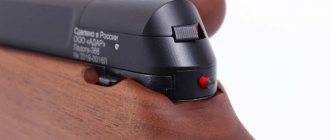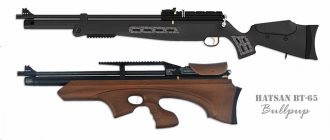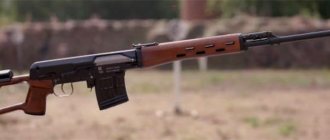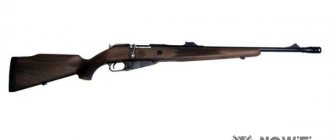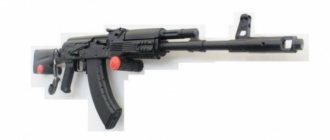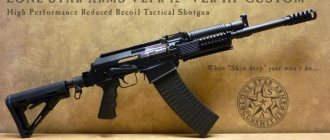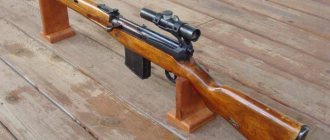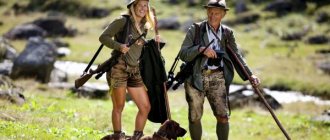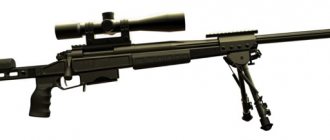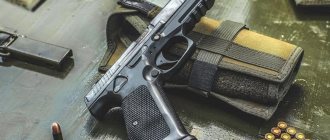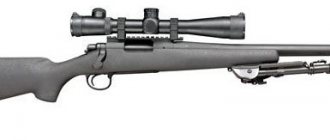| Mauser 98k | |
| Type | repeating rifle/carbine |
| A country | Nazi Germany |
| Service history | |
| Years of use | 1935 - present |
| Adopted | 1935 |
| In service | Germany, Belgium, Yugoslavia, Vietnam, Iran, Israel, USSR (as a trophy) |
| Wars and conflicts | World War II, Vietnam War, Six Day War (1967), Yugoslav Civil War and others |
| Production history | |
| Designed by | 1935 |
| Manufacturer | Mauser, Steyr-Daimler-Puch, Erma Werke[d], Sauer, Zbroivka Brno and Wilhelm-Gustloff-Stiftung[d] |
| Years of production | 1935 — ? |
| Total issued | more than 15 million, taking into account post-war production, more than 20 million. |
| Characteristics | |
| Weight, kg | 3,7—4,1 |
| Length, mm | 1110 |
| Barrel length, mm | 600 |
| Cartridge | 7.9 mm S-Patrone |
| Caliber, mm | 7,9 |
| Work principles | rolling shutter |
| Rate of fire, rounds/min | 15 (combat) |
| Initial bullet speed, m/s | 760 |
| Sighting range, m | 1500 |
| Type of ammunition | integral magazine for 5 rounds, loaded with clips |
| Media files on Wikimedia Commons | |
Mauser 98k (Mauser 98k)
is a repeating rifle (in German sources: Karabiner 98k, Kar98k or K98k), officially adopted for service in 1935. It was the main and most widespread small arms of the Wehrmacht. Structurally, it is a shortened and slightly modified modification of the Mauser 98 rifle.
Story
Mauser 98k is a relatively late release.
The butt plate is deep stamped, the front stock ring is stamped. Mauser sliding bolt. The original designation “carbine” for this sample is not correct from the point of view of Russian-language terminology: the Mauser 98k is more correctly called a “shortened” or “lightweight” rifle, since the German term “carbine” (Karabiner)
in its meaning used in those years does not correspond to the understanding of this word accepted in the Russian language. In terms of its dimensions, this “carbine” was only very slightly inferior, for example, to the Soviet “three-ruler”. The fact is that this word in the German language at that time only meant the presence of more convenient side, “cavalry” belt mounts - instead of “infantry” swivels located below on the stock. For example, some German "carbines" were significantly longer than rifles of the same model. This terminological difference gives rise to a certain confusion, aggravated by the fact that subsequently in German the term “carbine” acquired its “usual” meaning and also began to designate a very shortened rifle.
The letter "k" at the end of the name is an abbreviation of the German word "Kurz" - "short".
The Mauser 98k rifle was produced until 1945, more than 14 million copies were produced.
After World War II, the Mauser 98k rifle was in service in many countries around the world, including the GDR and the Federal Republic of Germany. As of 1995, the Mauser 98k rifle continued to be used by Bundeswehr honor guards[1].
In 1998, in honor of the 100th anniversary of the creation of the Mauser 98, the Mauser company released a batch of 1998 rifles - exact copies of the Mauser 98k from the times of Nazi Germany[2].
Russian upright: new Ladoga carbine
PHOTO BY THE AUTHOR.
The Ladoga hunting rifle from is the team’s first experience in the design and production of full-fledged firearms, because before that the company had been developing and manufacturing products such as wooden pistol grips, knives, stocks, and forends for weapons from other manufacturers for more than ten years.
For more than ten years, the company’s employees have visited many exhibitions and made a lot of presentations, but, as their leader Alexander says, there is no such excitement as at the “Weapons and Hunting 2018” exhibition held in Moscow at the end of last year, where this hunting weapon was exhibited for the first time the carbine was nowhere to be found.
Indeed, in the first three hours of the exhibition, more visitors visited the stand than in all previous years combined.
And this attention is understandable, because the creation of the product, proudly presented by the St. Petersburg company, was relatively quiet and fast, and the announcement was unexpected.
The first developments appeared less than two years ago, at the end of 2016, and already at the end of September it was possible to assemble the first prototype, i.e. By the standards of weapons production, everything happened in a very short time.
According to chief designer Vsevolod Sukhnev, such a high speed of development was facilitated by Ruslan Nikolaevich Chumak, head of the artillery funds department of the Military Historical Artillery Museum of St. Petersburg, and consultations by Mikhail Degtyarev.
Initially, the hunting rifle was planned as a traditional bolt-action rifle, with the bolt handle turning to unlock the barrel, but in the process of creating the first prototypes, the designers realized that the cost of a product with such a mechanism, given the production capacity, would be too high.
Then the project manager, Alexander Mikhailovich Rubin, proposed the idea of making a gun based on the so-called straight shotgun - a mechanism where, to unlock the barrel, the bolt handle is pulled in a straight line, without turning.
As a result, on September 19, 2022, on Gunsmith’s Day, the first shot was fired from the prototype, which became the basis for the Ladoga-336 smooth-bore hunting rifle in .366 TKM caliber with an oval-helical barrel profile (“Lancaster”).
| PHOTO BY THE AUTHOR. |
Next, the design team had to “treat,” in the words of the project manager, “a number of childhood diseases.” During the treatment process, it was necessary to abstract from other people's design solutions and come up with our own.
As a result, such solutions were developed, patented and successfully applied in the current design.
Let's start with what immediately catches your eye: the Ladoga is the only carbine in Russia that has a similar design of the bolt mechanism, which, unlike the classic bolt action, allows the shooter to experience much less discomfort when chambering a cartridge into the barrel. and once again do not take your eyes off the goal.
The bolt cylinder is removable and has three lugs; it is likely that everything will still be finalized so that the process of jerking the bolt becomes softer and smoother, but, as the chief designer says, the rifle requires a little skill, although, as those who have already tested the carbine note, it is more impossible than possible to slowly chamber a cartridge, and this causes some difficulties when being close to the target of hunting.
This problem arose precisely because of the design of the bolt mechanism, or rather, the latch, which blocks the bolt from moving backward. The passport even indicates in red that the gun must be cocked with an energetic movement.
Having tried to work the shutter, you understand that it will not be possible to close it slowly using the shutter handle; you need a sharp and confident movement, but if you push the shutter from behind with your thumb, everything will go with a bang. Is it good or bad?
Of course, this is not good: the weapon must work reliably no matter how the bolt is moved, but it is good that a way has been found to force the bolt to close without suddenly moving forward.
The second thing that the creators of the hunting rifle themselves, and those who managed to test it in action, note is a pleasant and smooth descent. Thanks to it, you feel comfortable shooting and get excellent results in hitting targets accurately and in accuracy too.
It is interesting to compare the carbine with its direct competitors, such as the Kalashnikov TG2 from the Kalashnikov concern, the VPO-208 and the SKS 306 Lancaster from Hammer Arms LLC.
Each has its own pros and cons, and it is not entirely correct to discuss subjective aspects such as convenience and comfort of shooting from the point of view of which is better, but nevertheless, many weapons bloggers have already noted the comfort and smooth descent. By the way, the stated trigger pull is 2.0–2.5 kg.
| PHOTO BY THE AUTHOR. |
We would also like to note the comfortable stock of the gun. And if the previous points can be considered controversial, then everyone speaks only positively about the box.
Yes, this is not surprising, because ADAR is a subsidiary that produces wooden products, including wooden handles, stocks and forends for rifles.
The only comment (possibly a private one) concerns the rather short butt, which is why when reloading the bolt group is located too close to the eye.
A hunting stock made of walnut will be supplied as standard, and in addition you can purchase either the “Ladoga Vector” stock in red and black with an adjustable cheek piece, or the more militaristic version “Ladoga Tactics-1”, made in black and having an adjustable cheek rest. Their cost is the same - almost 15 thousand rubles.
In total, the company presented four product versions at the exhibition: “Classic”, “Hunting”, “Sport” and “Tactics”.
In the upper part of the barrel, on the coupling, there is a special mount for a bracket for an optical sight; it has a length of 5 centimeters and only one transverse cutout, which after a certain number of shots can cause a slight displacement of the bracket.
Since this mount is a bit short and the bracket is secured with one bolt from the edge, the main body of the bracket is as if suspended in the air and has a weight limit of 700 g for the sighting device. The bracket itself can be purchased in a store for 9 thousand rubles.
The base of the carbine has a front sight and rear sight with light-concentrating inserts to make aiming easier.
The two-position (left/right) safety is located at the rear of the bolt group and is easily operated with the thumb. True, the fuse protrudes by several millimeters, and how convenient it will be to use it in winter with gloves is a big question.
Perhaps this problem will be solved during the finalization process, because the designers are aware of this. There is a cocking indicator under the safety; its base is painted red and is clearly visible.
| The barrel is removable and can be replaced with a barrel of a different caliber. PHOTO BY THE AUTHOR. |
Another feature of this gun is its multi-caliber, or more precisely, its use of a cartridge based on the 1943 cartridge case, that is, 7.62x39 mm, 6.5x39 mm Grendel and .366 TKM.
Currently, the carbine is only produced in .366 TKM, but the developer promises an additional range of barrels after they go through the licensing process, approximately in the second or third quarter of 2019.
The barrels themselves are attached to two screws at the bottom of the stock; a hexagon is included in the kit. The barrel length is 500 mm, which, as stated, provides an effective firing range of 150 meters.
At the end of the barrel, a thread is already cut from the factory for DTK or flash suppressors, which is supplied with a plug screwed onto it. And what’s interesting is that the thread is left-handed. It is also planned to release a Dual-Brake type muzzle brake.
The bore and chamber are chrome plated for increased durability and corrosion resistance.
The carbine has a magazine with a capacity of four rounds. The single-row compact magazine is completely buried in the fore-end and does not interfere with shooting. It is made in silver color, which is convenient when searching for it in foliage or grass. The weight of the carbine without magazine, case and belt is no more than 3.2 kg, its total length is 985 mm.
The carbine has been extensively tested: the “dry” test of 10,000 cycles passed without any complaints. Also, 15 test rounds and more than 6,000 regular rounds were fired from it, including in mud, sand and in the cold.
At the beginning of this year, Ladoga-366 was put into production, and then a new product, Ladoga-366 Compact, was presented at the Fifth All-Russian Arms Forum in Kostroma. It has an integral barrel 360 mm long and a slightly modified stock, the total length of the product is 810 mm.
Now the Ladoga carbine is available at a price of 58,990 rubles in many online stores, but you will still have to buy the weapon yourself and in person.
| PHOTO BY THE AUTHOR. |
To sum it up, it released a very unique product: in some places, due to the features of the sliding bolt, there were slight inconveniences in chambering a cartridge, and in others, for example, in the rate of fire, on the contrary, there were indicators almost unattainable with classic “bolt bolts” 4 shot in less than 4 seconds.
But the stock especially stood out (except, of course, the upright one). It is beautiful, comfortable, for every taste and purpose, and this is understandable: after all, the main focus of the company for more than ten years has been wooden stocks, handles and forends. The overall dimensions of the gun and its weight are quite acceptable and give an average feeling when shooting.
All that remains is to wish success to the chief designer of Ladoga-366, Vsevolod Sukhnev, and the gunsmiths from the glorious city on the Neva. After all, this is their first brainchild, and a very promising one, into which they invested, if not their soul, then a lot, a lot of effort.
Könas Nisherg July 16, 2022 at 12:16 pm
Manufacturers
Mauser 98k was produced by the following companies[3]:
- Mauser Werke AG, plant in Oberndorf am Neckar[4];
- Mauser Werke AG, plant in Borsigwald, a suburb of Berlin[5];
- JP Sauer und Sohn Gewehrfabrik, plant in Suhl[6];
- Erfurter Maschinenfabrik (ERMA) (English), plant in Erfurt[7];
- Berlin-Lübecker Maschinenfabrik, plant in Lübeck[8];
- Berlin-Suhler-Waffen und Fahrzuegerke[9];
- Gustloff Werke, plant in Weimar[10];
- Steyr-Daimler-Puch AG, plant in Steyr (Austria)[11];
- Steyr-Daimler-Puch AG, workshops in the Mauthausen concentration camp (Austria);
- Waffen Werke Brunn AG, plant in Povazska Bistrica (Slovakia)[12].
Design and principle of operation
The design of the Mauser 98k is generally similar to that of the Mauser 98. Key features of the Mauser 98k include:
- shorter barrel (600 mm instead of 740 mm for the Mauser 98); Disassembled receiver of a Mauser 98k rifle
- shutter handle bent down;
- slightly reduced length of the stock and the presence of a recess in it for the bolt handle;
- a metal disk in the through hole of the butt (grommet), used as a stop when disassembling the bolt;
- “cavalry” sling fastening (instead of “infantry” swivels on the Mauser 98) - the front swivel is combined into one part with the rear stock ring, and instead of the rear swivel there is a through slot in the butt;
- in the Mauser 98 rifle, the clip must be removed manually after loading the magazine with cartridges; in the Mauser 98k, the clip was ejected when the bolt moved;
- The feeder device was changed - after the cartridges from the magazine were used up, it did not allow the bolt to close.
The Mauser 98k rifles were equipped with standard SG 84/98 bayonets, which were significantly shorter and lighter than the bayonets provided for the Mauser 98[13]. Such a bayonet had a blade 25 cm long with a total length of 38.5 cm. Massive bayonet battles were uncharacteristic of the Second World War, therefore, in order to save money, from the end of 1944, rifles were no longer equipped with bayonet knives; they did not even have a bayonet mount and a ramrod. In addition to the standard bayonet, the SG 42 model was adopted for service, although it was not included in the series. SG 42 had a length of 30 cm with a blade length of 17.6 cm.
The Mauser 98k rifles were equipped with very short cleaning rods (standard cleaning rods with a length of 25 cm and 35 cm are known) - in order to clean the bore, it was necessary to screw two cleaning rods together[13].
Standard rifles were used as sniper rifles; those that gave maximum accuracy were selected from the batch. For shooting, SmE (Spitzgeschoss mit Eisenkern - pointed bullet with a steel core) cartridges were used.
It's time to remember the athletes
Practical shooting has existed in Russia since the late 90s; it is a completely official (though not Olympic) sport. And in the last couple of years, the PCC discipline (pistol-caliber carbines, “carbines chambered for a pistol cartridge”) has become quite popular. A “Saiga” straight from the store, without a body kit, is, of course, not the most successful option for competitions, but after replacing the stock, forend, installing a sight, etc., it becomes quite similar to a “sports blaster.”
"Saiga-9" in a sports body kit
Additional accessories
During the Second World War, a muzzle grenade launcher and curved attachments (smoothbore) were adopted for the Mauser 98k rifle, making it possible to fire from behind cover (from around a corner, etc.)[14].
Muzzle grenade launcher 1943 Muzzle grenade launcher 1944
The standard Gewehrgranat Geraet 42 rifle grenade launcher was attached to the barrel using a folding clamp. The maximum firing range is up to 250 m. There were approximately 7 types of grenades for the grenade launcher.
The GG/P40 (Gewehrgranatgeraet zur Panzerbekaempfung 40) barreled anti-tank grenade launcher was designed specifically for paratroopers. It was lighter and smaller than the standard GG 42, produced in a small batch, attached to a rifle like a bayonet, and was intended to combat enemy armored vehicles.
Krummlauf is a device for shooting from behind cover, capable of turning the bullet's travel by 30 degrees. It was attached to the rifle barrel using the same mechanism as the barrel grenade launcher. Developed in 1943, after several prototypes were produced, the main focus of work on barrel curvature was transferred to assault rifles.
Winterabzug – a device for shooting a rifle in winter. Developed in 1942, officially adopted in 1944. The winter release consisted of an oval tin container with a lever inside and an external trigger located on the side. The container was placed on the trigger safety guard. By turning the outer trigger back, the shooter carried out the descent. It is unknown how many of these devices were made, but it was widely used by snipers because it allowed them to shoot in winter without taking off their mittens.
There are two known silencers for the Kar.98k: one 25.5 cm long with a spiral surface, the other 23 cm long. They were put on the barrel using a clamp similar to the mount for a barrel grenade launcher. Subsonic cartridges were used. No further details available.
Telescopic sights
The first type of telescopic sight officially adopted by the German army was the ZF 39 (Zielfernrohr 1939). Otherwise, this sight was called Zielvier (“four-fold”), this name was also applied to other sights that provide four-fold magnification. In 1940, the sight received a standard graduation for a distance of up to 1200 m. It was installed above the bolt; during the war, the mounting design was repeatedly improved.
In July 1941, another sight was adopted - the ZF 41 (Zielfernrohr 41), also known as the ZF 40 and ZF 41/1. Kar.98k rifles equipped with the ZF 41 began to enter the army at the end of 1941. With a length of 13 cm, it provided only one and a half times the magnification, and was attached to the left side of the rear sight, so it did not interfere with loading the magazine from the clip. Due to its 1.5x magnification, this sight could only be used for medium-range shooting. A rifle with such a scope was positioned as a rifle for high-precision shooting, and not as a sniper. At the beginning of 1944, ZF 41 sights were removed from many rifles, but production of the ZF-41/1 continued until the end of the war. According to modern criteria, such sights are closer to collimator sights; their use is due to the blitzkrieg plan, according to which trench warfare was not planned[15].
After the collapse of the concept of lightning war, various commercial sights with a magnification of 4X to 6X, poorly suited for military service, were adopted under the designation ZF-42[16].
In 1943, a cheap and reliable telescopic sight ZF 4 (or ZF 43, ZFK 43 and ZFK 43/1) with a 4X magnification, designed under the influence of the Soviet PU sight, appeared [16]. It was intended for the G43 self-loading rifle, but it was not possible to produce the G43 in sufficient quantities and the sight had to be adapted to the Kar.98k rifle. The sight was placed above the bolt on a swept-back mount, adopted a few months before the end of the war and produced in a limited series.
There were other types of sights. For example, the Opticotechna sight. Quadruple telescopic sights Dialytan and Hensoldt & Soehne. Rare Carl Zeiss Jena Zielsechs six-power telescopic sight.
According to a very rough estimate, about 200,000 Kar.98k rifles were equipped with telescopic sights. About half of this amount is for the ZF 41 scope, and the other half is for other types of scopes.
Let's start with the Kalashnikov...
The first sign was VPO-132 (“Vepr-9”) - a product originally from Vyatskiye Polyany.
Despite the frankly weak ammunition, the creators used a “heavy” receiver from a Kalashnikov light machine gun and added a heavy butt (the weight was almost four kilos). In order not to bother with ammunition, the factory workers adapted magazines from Ch-Z and Glock pistols to the Vepr.
Carbine VPO-132 (“Vepr-9”) caliber 9x19 mm
As expected, the first pancake came out lumpy. The reliability of the carbine turned out to be below any criticism. After all, to create even such a model from scratch, you need quite impressive funds, which domestic enterprises are constantly lacking. Therefore, Vyatskopolyansky took up conversion: we take the old Soviet PPSh-41, weld the fire translator - and...
Hunting carbine PPSh-O (VPO-135)
By the way, connoisseurs of domestic weapons can find other submachine guns from the Second World War (PPS-43, PPD-40, MP-38/40) for their collection. Although they are rarely on sale, the price tag on them can confuse an unprepared person.
The main difference between the newly-minted “carbines” and their military ancestors is the absence of a burst firing mode, a strictly regulated by law total length (at least 800 mm in firing position) and a limited magazine capacity (no more than ten rounds).
For those who want to have something more exotic in their home arsenal, a domestic manufacturer (this time the Zlatoust Machine-Building Plant) offers, for example, the Krechet carbine (nee PP-71/PP-91 submachine gun, consisting of weapons in the Ministry of Internal Affairs).
PP-71…
...and the KSO-9 Krechet carbine
“Krechet” truly personifies the phrase “terrible as mortal sin.” With such an appearance, there is no thought to be interested in his combat characteristics. However, from the PP-71 and its descendant, the PP-91, they have already made a service pistol for private security guards (PKSK), and a traumatic one (PDT-9T “Esaul”), and a pneumatic one (Tirex)... So the poor piece of iron is not get used to it.
Post-war production
Main article: Zastava M48
In 1950-1965, the M48 rifle, a structurally improved version of the Mauser 98k, was produced in Yugoslavia in the city of Kragujevac (now Serbia). The M48 rifle had modifications M48A, M48B, M48BO. Until now (2021), the Zastava Arms company has been producing a modification of the M48 rifle - the M48/63 sports rifle (chambered 7.92x57 mm)[18].
In addition, until now (2012), the Zastava Arms company has been producing the M98 sports rifle, which uses a bolt structurally similar to the Mauser 98 bolt (available in different calibers)[19].
In addition to Yugoslavia, rifles of this type were also produced in France, Turkey, Czechoslovakia, India and Israel. The total production of “post-war” Mausers exceeded 5 million units.
...and we’ll finish with a Kalashnikov
Vyatskie glades, Zlatoust - where is Izhevsk? Of course, it will not be possible to do without the main player in the Russian arms market. The Kalashnikov concern has been developing an AK-based submachine gun for quite some time. PP-19 “Vityaz” is a descendant of the experimental “Bison” with an auger magazine for 64 rounds, created back in 1993 by order of the Ministry of Internal Affairs.
PP-19 "Bison" with auger magazine chambered for 9x18 mm
True, it was the PP-19-01 modification with a completely ordinary sector magazine that came into service - and only in 2004. And ten years later, a civilian version of Saiga-9 appeared (Izhevsk residents have never been famous for the speed of releasing new models to the market).
PP-19-01 “Vityaz-SN” and “Saiga-9” caliber 9x19 mm
Despite some childhood illnesses, Saiga is currently the most popular representative of the Russian line of carbines chambered for a pistol cartridge. But you can’t make money with “plinkers” alone.
So who buys all these runts?
Hunting options in Russia
The Mauser 98k rifle in Russia is in civilian use as a hunting rifle. At the same time, in civilian use, the Mauser 98k rifle has several official name options:
- KO-98M1
(Tula Arms Plant)[20] - Mauser 98k rifle chambered for the original 7.92x57 mm cartridge; - OTs-63
(TsKIB) - Mauser 98k rifle chambered for the original 7.92x57 mm cartridge; - KO-98
- Mauser 98k rifle, chambered for .308 Win (7.62×51 mm)[21]; - VPO-115
(Vyatsko-Polyansky Machine-Building) is a Mauser 98k rifle chambered for the .30-06 Springfield cartridge (7.62×63 mm). - VPO-116M
(Vyatsko-Polyansky Machine-Building) is a Mauser 98k rifle chambered for .243 Winchester (6.2×52 mm). - 98k - (Vyatsko-Polyansky Machine-Building) - Mauser 98k rifle, caliber 8x57 JS (produced under this designation in 2004-2005).
Mauser "Hammer" carbines
The world-famous Model 98, Paul Mauser's last contribution to the development of the repeating rifle, turned out to be so successful that to this day the designers have not been able to make any significant improvements to its mechanism.
Far from being a great leap of genius, the Mauser M98 was largely the result of 30 years of tireless work, starting with the first prototype of a single-shot bolt-action rifle proposed in 1867.
The first foreign tender won by the Mauser brothers was announced in 1879 by the government of newly independent Serbia. It was a competition for a rifle for his army. In intense competition with the largest arms companies, the model of Wilhelm and Paul Mauser, which was an improved version of the 1871 model rifle, won. It was almost a miracle that a simple gunsmith from Oberndorf (Wilhelm Mauser was a model) managed not to get lost in the web of intrigue of his competitors and the corruption inherited from the Ottoman Empire by the young Balkan state. At the end of 1880, the model was accepted by the Serbian War Ministry under the designation “rifle model 1878/80”, and in February 1881 Wilhelm Mauser returned to Oberndorf with an order for 100 thousand rifles. For the arms factory in Oberndorf, which had had no large orders for several years before, this was a salvation. Residents of the city celebrated his return with a torchlight procession. In 1882, the implementation of the Serbian order began. This is how the Mauser first appeared on Serbian soil.
Subsequently, the production of “Mausers” was also mastered by the Serbian arms industry, since they could not count on supplies from Oberndorf: quite soon (during the First World War) Serbia and Germany found themselves in different alliances of states that fought against each other.
The Zastava Arms weapons factory in the city of Kragujevac, 100 km south of Belgrade, was founded in 1853. Until recently it was called "Crvena Zastava" (Red Outpost). In the 80s, up to 90% of production volume was occupied by military products, the range of which can be called wide - from CZ99 pistols to the 20-mm M55AZV1 anti-aircraft gun. The number of employees exceeded 8 thousand people. Currently, the ratio between the military and civilian production sectors is 50:50. The number of employees also decreased: by mid-2003 it was 3,590 people. The NATO bombing caused enormous damage to the enterprise; 20 thousand square meters of production space were destroyed, material damage amounted to 60 million euros.
Zastava Arms' civilian products include repeating carbines and classic double-barreled shotguns, with the company's main "workhorse" being, of course, carbines based on the Mauser M98 system. Like all Zastava Arms products, hunting weapons are distinguished by good quality at a reasonable price.
VPO-105
Since the mid-90s, Serbian gunsmiths have been trying to establish business contacts with Russian arms enterprises. However, the sanctions imposed by the UN decision prevented such cooperation. With the lifting of sanctions, favorable conditions were created for cooperation between gunsmiths of the two countries, which were taken advantage of by the Vyatsko-Polyansky Machine-Building Plant, which, together with the company Zastava Arms, began the production of store-bought hunting carbines of the VPO-105, VPO-106 models.
For the Russian arms industry, this is the second experience of joint production: the first was a joint project of the Izhevsk Mechanical Plant on the KSP-200 sports pistol, which was a tuned IZH-35M by a German company.
Hunting carbines VPO-105, VPO-106 are based on the classic design of the Mauser M98. What does it mean?
This is, first of all, a Mauser bolt, tested on millions of products, both military and hunting, with two symmetrically located protrusions in the head part, a reliable ejector with a wide tooth, simple disassembly - if disassembly is incomplete, the bolt is disassembled into three units. A feature of the classic Mauser bolt is an open cup at the bottom and a long spring ejector, under the tooth of which the sleeve groove is guaranteed to fit, ensuring 100% reliability of removing the cartridge case or cartridge. The special attention that Paul Mauser paid to this unit was due to a sad experience with a rifle of the 1888 model - the so-called “model of the Rifle Testing Commission” (Komissionsgewehr). Due to the imperfect design of the bolt of the M88 rifle, there were frequent cases when the ejector did not engage the groove of the cartridge case inserted into the chamber. In this case, the shooter could resend the cartridge, which would be stuck with the head part into the primer of the cartridge remaining in the chamber. The result was a shot with the bolt open, resulting in injury to the shooter and damage to the rifle. With the Mauser M98 this was completely excluded!
The reliability of the extraction mechanism is increased by the preliminary shift of the cartridge case when the bolt is unlocked due to the interaction of the base of the bolt handle with the bevel on the rear bridge of the receiver. This ensures ease of extraction, even when firing cartridges with the maximum permissible powder charges.
This is an integral middle double-row magazine with 5 rounds, loaded from above through the receiver window. The receiver window is large enough to provide ease of loading, but the strength of the box does not suffer. The permanent magazine is guaranteed not to be lost in the thicket of the forest or in the bushes.
And now - about the main differences.
On the original design, the fuse was located on the bolt. When turned on, it blocked the firing pin and prevented the bolt from opening. In the VPO-105 carbine, the safety box has been moved to a more convenient place, on the right side, behind the bolt handle. When turned on, which is done by moving the flag backwards, the trigger and bolt are blocked. Turning off the safety is done by the most natural movement of the thumb - forward. The safety locks into place without clicking, which is of great importance when hunting from a tower.
When you press the trigger, it does not retract the sear, but releases it. Due to the fact that with this scheme the position of the working surface of the sear does not ensure its self-braking, under the influence of the mainspring it is recessed, releasing the firing pin. This principle provides less force on the trigger. The trigger mechanism is equipped with adjustments for the trigger force and trigger travel.
The open sight provides an accurate shooting range of up to 300 m. An optical sight can be installed on the upper surface of the receiver.
The VPO-105 and VPO-106 carbines are produced for .308 Winchester (7.62×51) and .30-06 (7.62×63) cartridges, respectively. If the 7.62×51 cartridge is already quite well known to Russian hunters, then the .30-06 cartridge should be talked about in a little more detail.
At the beginning of the 20th century in the USA it was adopted as an army cartridge. In this capacity, he went through three wars - the First, Second World Wars and the Korean War (1950-53). Currently, it is considered the most versatile cartridge of the variety that is offered to US hunters. It has, in fact, become the standard in the group of cartridges aimed at large game.
The variety of weight characteristics and bullet designs - from 6.48 to 14.3 g and from full-jacket to a wide variety of expansive ones - allows you to cover almost the entire spectrum of hunting scenarios: varmint, medium and large ungulates, bear, most of the African hunting fauna (except, of course, "Big Five") The .30-06 cartridge is produced by all the world's leading manufacturers; its production has also been mastered by the domestic industry of Barnaul Machine Tool Plant OJSC.
VPO-106
Good characteristics of accuracy and survivability are ensured by a barrel manufactured using the most modern technology of cold rotary forging and a chrome-plated channel. The company's extensive experience in the manufacture of machine gun barrels, which have always been subject to increased survivability requirements, guarantees that the VPO-105, VPO-106 carbines will faithfully serve more than one generation of hunters.
A stock made of selected Turkish walnut with a pistol-shaped neck and a rubber shock absorber provides comfortable aiming and promotes effective recoil damping.
In general, we can say that the new Vyatsko-Polyansky model, combining design solutions proven by many years of operation and accepted by the hunting community with modern technology used in the manufacture of main parts, will provide an optimal price-quality ratio for its price niche.
Anatoly Osipov
Mauser 98k operating countries
- Germany[22]
- German Democratic Republic[22]
- Denmark[22]
- Israel[22]
- Indonesia[23]: The Indonesians used K 98k captured from Dutch troops during the Indonesian War of Independence.
- People's Republic of China[22]
- Republic of China[24]
- Luxembourg. The Grand Duke's Guard used K98k taken from German troops in 1945, later changing to Ross rifles in the same year[25]
- Malaysia
- Nazi Germany[26]
- Netherlands Used after the end of World War II
- Norway[27]
- Pakistan (after 1945)
- Poland
- Portugal[28]
- San Marino
- Serbia[29]
- Slovakia[30]
- USA captured rifles.
- Türkiye[23]
- Finland (Bought from the Germans. Mainly used in conjunction with a grenade launcher for a rifle)
- France[22]
- Croatia[29]
- Czechoslovakia (after 1945)[22]
- Sweden. In 1939, Sweden received 5,000 Kar 98k rifles[31]
- Ethiopia. Ethiopian patriots used captured rifles against Axis forces from 1941[32]
- Yugoslavia[22]
- Various formations around the world.
Non-state actors
- Korean Liberation Army (a group of guerrilla forces that fought for Korean independence during the Japanese occupation)[22]
Literature
- Bolotin D.N.
History of Soviet small arms and cartridges. - St. Petersburg: Polygon, 1995. - 304 p. — ISBN 5-85503-072-5. - Monetchikov S.
“Miracle weapon” - a weapon of despair? // Magazine "Brother". - 2006. - No. 11. Archived on August 12, 2011. - A.B. Bug. Weapon. Revolvers, pistols, rifles, submachine guns, machine guns. M: Military Publishing House, 1992 – 707 p.
- S.V. Ivanov. Soldier at the front No. 59. German Kar 98k rifle. Beloretsk, 2005 – 64 p.
- Andrey Koromyslov. “Ninety-eighth, short” // “Master Gun” magazine, No. 6 (99), June 2005. pp. 10-15
Notes
- Article in Der Spiegel magazine No. 38, 1995.
- Mauser: 98 Rifle and 98K Carbine. Anniversary issue 1998. Description on the manufacturer's website. (unspecified)
(inaccessible link). Access date: February 19, 2011. Archived January 15, 2008. - "claus.espeholt.dk"
- History of 98k production at the Mauser plant in Oberndorf am Neckar Archived June 26, 2011.
- History of 98k production at the Mauser plant in Borsigwald Archived September 12, 2011.
- History of 98k production by Sauer Archived August 4, 2016.
- History of 98k production by ERMA Archived June 17, 2012.
- History of 98k production by Berlin-Lübecker Maschinenfabrik Archived September 11, 2011.
- History of 98k production by Berlin-Suhler-Waffen und Fahrzuegerke Archived September 12, 2011.
- History of 98k production by Gustloff Werke Archived January 26, 2009.
- History of 98k production by Steyr-Daimler-Puch Archived July 10, 2012.
- History of 98k production by Waffen Werke Brunn Archived September 10, 2011.
- ↑ 1 2
description of Mauser 98 on the website gewehr.ru
(unspecified)
(inaccessible link). Access date: February 5, 2011. Archived August 17, 2016. - Bolotin, 1995, p. 251-252.
- Popenker M.R., Milchev M.N. World War II: The Gunsmiths' War. M.: Yauza, Eksmo, 2008. p. 193
- ↑ 12
Popenker M.R., Milchev M.N. World War II: The Gunsmiths' War. M.: Yauza, Eksmo, 2008. p. 194 - Monetchikov, 2006, No. 11.
- Description of the M48/63 on the zastava-arms website Archived March 10, 2012.
- Description of the M98 on the zastava-arms website Archived May 7, 2012.
- Nikolai Dergachev, Alexander Kudryashov. Article "KO-98M1 from the Mauser 98K family." Magazine "Caliber" No. 12, 2002
- Magazine "Caliber" No. 1 for 2001. Test of the issue. Mauser KO 98
- ↑ 123456789
"Mauser Bolt Rifles by Ludwig Olsen, 3rd edition, F. Brownell and Son, Publisher, p. 126 - ↑ 12
Brassey's Infantry Weapons of the World, 1950–1975, J. I. H. Owen (1975), p. 57 - Ball, Robert: Mauser Military Rifles of the World
Gun Digest Books, 2006 - GRAND-DUCHY OF LUXEMBOURG Archived January 26, 2011.
- The Encyclopedia of Weapons of World War II - Chris Bishop - Google Books
- Ball, Robert: Mauser Military Rifles of the World
. Gun Digest Books, 2006 - Ball, Robert: Mauser Military Rifles of the World
. Gun Digest Books, 2006 - ↑ 1 2
Bishop, Chris.
Guns in Combat
. Chartwell Books, Inc (1998). ISBN 0-7858-0844-2. - Axworthy, Mark W. (2002), Axis Slovakia: Hitler's Slavic Wedge 1938–1945, Europe Books Inc., ISBN 1-891227-41-6
- Swedish rifles – Gev m/39 and m/40 gotavapen.se
- McNab, Chris.
20th Century Military Uniforms (undefined). — 2nd. - Kent: Grange Books, 2002. - ISBN 1-84013-476-3.
